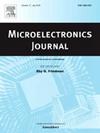金属栅极应变工程下GAAFET沟道几何驱动性能增强
IF 1.9
3区 工程技术
Q3 ENGINEERING, ELECTRICAL & ELECTRONIC
引用次数: 0
摘要
金属栅(MG)应变工程从45纳米节点开始应用于CMOS技术,以提高器件性能。由于MG应变工程和相应的性能增强严重依赖于底层通道的几何形状,因此需要在具有不同3D通道架构的高级逻辑器件中严格研究MG应变效应。在这项工作中,我们使用3D技术计算机辅助设计(TCAD)模拟研究了mg -应变Si技术在3纳米节点的finfet和纳米片fet (nsfet)上的性能影响。由于NS的沟道几何形状不同,p型nsfet获得了更大的驱动电流增强(ΔIon)和迁移率增强(Δμ)。Si通道应变分布分析表明,纳米片通道中较大的纵向(ZZ)压应力和横向(YY)拉应力是Si通道性能增强的主要原因。随后,我们的研究表明,通过减小纳米片厚度或增加纳米片宽度,可以提高MG应变Si技术在p型nsfet中的有效性。本文章由计算机程序翻译,如有差异,请以英文原文为准。
Channel geometry-Driven performance enhancement under metal gate strain engineering in GAAFET
Metal Gate (MG) strain engineering has been employed in CMOS technology since the 45 nm node to enhance device performance. Since the MG strain engineering and corresponding performance enhancement critically depend on the geometry of the underlying channel, the dependency necessitates rigorous study of MG strain effects in advanced logic devices with diverse 3D channel architectures. In this work, we investigate the performance impact of MG-strained Si technology across FinFETs and nanosheet FETs (NSFETs) at the 3-nm node using 3D Technology Computer-Aided Design (TCAD) simulations. With the distinct channel geometry of NS, larger driving current enhancement (ΔIon) and mobility enhancement (Δμ) are obtained on p-type NSFETs. Si channel strain distribution analysis shows that the performance enhancement can be attributed to the larger longitudinal (ZZ) compressive stress and the lateral (YY) tensile stress in the nanosheet channel. Subsequently, our investigation reveals that enhancing the effectiveness of MG strained Si technology in p-type NSFETs is achievable by reducing the nanosheet thickness or increasing its width.
求助全文
通过发布文献求助,成功后即可免费获取论文全文。
去求助
来源期刊

Microelectronics Journal
工程技术-工程:电子与电气
CiteScore
4.00
自引率
27.30%
发文量
222
审稿时长
43 days
期刊介绍:
Published since 1969, the Microelectronics Journal is an international forum for the dissemination of research and applications of microelectronic systems, circuits, and emerging technologies. Papers published in the Microelectronics Journal have undergone peer review to ensure originality, relevance, and timeliness. The journal thus provides a worldwide, regular, and comprehensive update on microelectronic circuits and systems.
The Microelectronics Journal invites papers describing significant research and applications in all of the areas listed below. Comprehensive review/survey papers covering recent developments will also be considered. The Microelectronics Journal covers circuits and systems. This topic includes but is not limited to: Analog, digital, mixed, and RF circuits and related design methodologies; Logic, architectural, and system level synthesis; Testing, design for testability, built-in self-test; Area, power, and thermal analysis and design; Mixed-domain simulation and design; Embedded systems; Non-von Neumann computing and related technologies and circuits; Design and test of high complexity systems integration; SoC, NoC, SIP, and NIP design and test; 3-D integration design and analysis; Emerging device technologies and circuits, such as FinFETs, SETs, spintronics, SFQ, MTJ, etc.
Application aspects such as signal and image processing including circuits for cryptography, sensors, and actuators including sensor networks, reliability and quality issues, and economic models are also welcome.
 求助内容:
求助内容: 应助结果提醒方式:
应助结果提醒方式:


